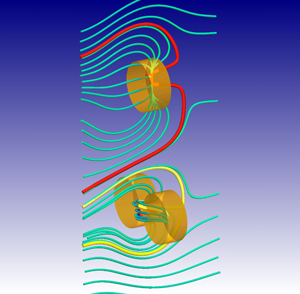A modern twist on Young’s slits

Example of the energy flow and optical vortices found around closely spaced gold nanoparticles. The effects resemble the field lines seen in Young’s slit experiments. Copyright : 2014 A*STAR Data Storage Institute
In the eighteenth century, scientists faced a conundrum: is light a wave or a particle? One of strongest pieces of evidence to support the ‘wave view’ — the landmark double-slit experiment — was reported in 1804 by the scientist Thomas Young. Young passed coherent light through two closely spaced slits and observed a set of interference fringes, a result that occurs with wave phenomena like sound or water. This observation became the basis for the modern wave theory of light.
Two hundred years later, Arseniy Kuznetsov and co-workers from the A*STAR Data Storage Institute, together with collaborators in Australia, Singapore, the United Kingdom and Russia, have performed an experiment analogous to Young’s experiments but using nanoscale objects (1). The team studied the light scattering in the visible and near-infrared wavelength regions from a cluster of two or three closely spaced gold plasmonic nanoparticles. They observed interference and resonance effects that resemble those seen in Young’s experiments.
In particular, while studying a trimer system consisting of three discrete metallic nanodisks of about 145 nanometers in diameter and 60 nanometers thick, the team found evidence for the presence of near-field, subwavelength-sized optical vortices and the circulation of electromagnetic energy (see image). This finding is very similar to what occurs to the energy flow pattern in a Young-type experiment performed with three slits.
One of the key issues in nanoplasmonics is the interaction between metallic nanoparticles at the nanoscale. “Even if the separation between two or multiple non-periodically arranged nanoparticles is of the order of wavelength, their interaction can be strong enough to change their scattering and absorption properties,” notes Kuznetsov. “This can be explained by the peculiarities of the Poynting vector (energy) flow around the nanoparticles and formation of optical vortices, which produce a pattern of field lines similar to Young’s classic experiment.”
The team’s findings, says Kuznetsov, not only expand our fundamental understanding of how light interacts with nanoclusters of metallic particles, but have both theoretical and practical applications. “They may also prove useful for applications such as improved solar cells and plasmonic biosensors.” However, their most remarkable application, he suggests, may be in the emerging area of nanoantennas.
In the future, the team is aiming to study the resonant properties and interactions of nanoparticles made from nonmetallic materials. In particular, they plan to investigate high-refractive index dielectric materials such as silicon, which, unlike metallic particles, do not suffer from high optical losses.
The A*STAR-affiliated researchers contributing to this research are from the Data Storage Institute
Associated links
Journal information
Rahmani, M., Miroshnichenko, A. E., Lei, D. Y., Luk’yanchuk, B., Tribelsky, M. I. et al. Beyond the hybridization effects in plasmonic nanoclusters: Diffraction-induced enhanced absorption and scattering. Small 10, 576–583 (2013).
Media Contact
All latest news from the category: Physics and Astronomy
This area deals with the fundamental laws and building blocks of nature and how they interact, the properties and the behavior of matter, and research into space and time and their structures.
innovations-report provides in-depth reports and articles on subjects such as astrophysics, laser technologies, nuclear, quantum, particle and solid-state physics, nanotechnologies, planetary research and findings (Mars, Venus) and developments related to the Hubble Telescope.
Newest articles

“Nanostitches” enable lighter and tougher composite materials
In research that may lead to next-generation airplanes and spacecraft, MIT engineers used carbon nanotubes to prevent cracking in multilayered composites. To save on fuel and reduce aircraft emissions, engineers…

Trash to treasure
Researchers turn metal waste into catalyst for hydrogen. Scientists have found a way to transform metal waste into a highly efficient catalyst to make hydrogen from water, a discovery that…

Real-time detection of infectious disease viruses
… by searching for molecular fingerprinting. A research team consisting of Professor Kyoung-Duck Park and Taeyoung Moon and Huitae Joo, PhD candidates, from the Department of Physics at Pohang University…





















